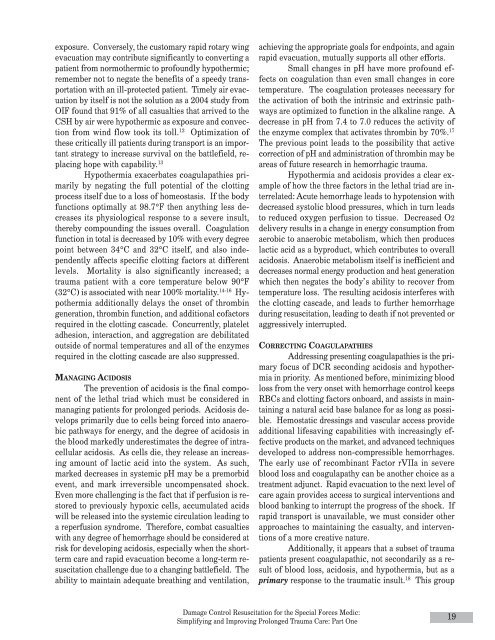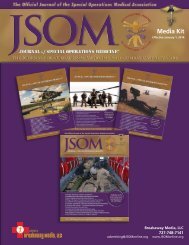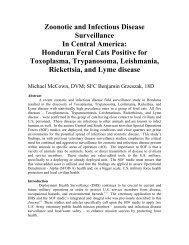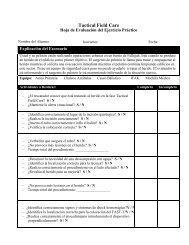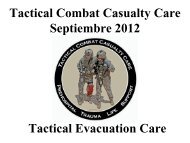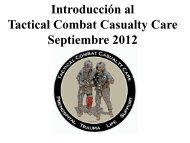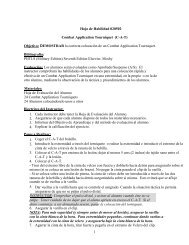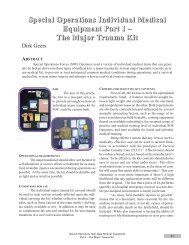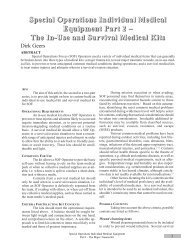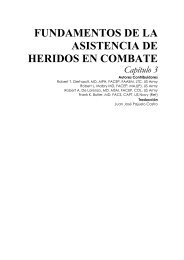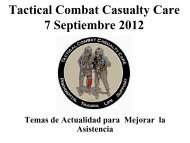Risk G. Hetzler M. Damage Control Resuscitation for the Special ...
Risk G. Hetzler M. Damage Control Resuscitation for the Special ...
Risk G. Hetzler M. Damage Control Resuscitation for the Special ...
You also want an ePaper? Increase the reach of your titles
YUMPU automatically turns print PDFs into web optimized ePapers that Google loves.
exposure. Conversely, <strong>the</strong> customary rapid rotary wing<br />
evacuation may contribute significantly to converting a<br />
patient from normo<strong>the</strong>rmic to profoundly hypo<strong>the</strong>rmic;<br />
remember not to negate <strong>the</strong> benefits of a speedy transportation<br />
with an ill-protected patient. Timely air evacuation<br />
by itself is not <strong>the</strong> solution as a 2004 study from<br />
OIF found that 91% of all casualties that arrived to <strong>the</strong><br />
CSH by air were hypo<strong>the</strong>rmic as exposure and convection<br />
from wind flow took its toll. 12 Optimization of<br />
<strong>the</strong>se critically ill patients during transport is an important<br />
strategy to increase survival on <strong>the</strong> battlefield, replacing<br />
hope with capability. 13<br />
Hypo<strong>the</strong>rmia exacerbates coagulapathies primarily<br />
by negating <strong>the</strong> full potential of <strong>the</strong> clotting<br />
process itself due to a loss of homeostasis. If <strong>the</strong> body<br />
functions optimally at 98.7°F <strong>the</strong>n anything less decreases<br />
its physiological response to a severe insult,<br />
<strong>the</strong>reby compounding <strong>the</strong> issues overall. Coagulation<br />
function in total is decreased by 10% with every degree<br />
point between 34°C and 32°C itself, and also independently<br />
affects specific clotting factors at different<br />
levels. Mortality is also significantly increased; a<br />
trauma patient with a core temperature below 90°F<br />
(32°C) is associated with near 100% mortality. 14-16 Hypo<strong>the</strong>rmia<br />
additionally delays <strong>the</strong> onset of thrombin<br />
generation, thrombin function, and additional cofactors<br />
required in <strong>the</strong> clotting cascade. Concurrently, platelet<br />
adhesion, interaction, and aggregation are debilitated<br />
outside of normal temperatures and all of <strong>the</strong> enzymes<br />
required in <strong>the</strong> clotting cascade are also suppressed.<br />
MANAGING ACIDOSIS<br />
The prevention of acidosis is <strong>the</strong> final component<br />
of <strong>the</strong> lethal triad which must be considered in<br />
managing patients <strong>for</strong> prolonged periods. Acidosis develops<br />
primarily due to cells being <strong>for</strong>ced into anaerobic<br />
pathways <strong>for</strong> energy, and <strong>the</strong> degree of acidosis in<br />
<strong>the</strong> blood markedly underestimates <strong>the</strong> degree of intracellular<br />
acidosis. As cells die, <strong>the</strong>y release an increasing<br />
amount of lactic acid into <strong>the</strong> system. As such,<br />
marked decreases in systemic pH may be a premorbid<br />
event, and mark irreversible uncompensated shock.<br />
Even more challenging is <strong>the</strong> fact that if perfusion is restored<br />
to previously hypoxic cells, accumulated acids<br />
will be released into <strong>the</strong> systemic circulation leading to<br />
a reperfusion syndrome. There<strong>for</strong>e, combat casualties<br />
with any degree of hemorrhage should be considered at<br />
risk <strong>for</strong> developing acidosis, especially when <strong>the</strong> shortterm<br />
care and rapid evacuation become a long-term resuscitation<br />
challenge due to a changing battlefield. The<br />
ability to maintain adequate breathing and ventilation,<br />
achieving <strong>the</strong> appropriate goals <strong>for</strong> endpoints, and again<br />
rapid evacuation, mutually supports all o<strong>the</strong>r ef<strong>for</strong>ts.<br />
Small changes in pH have more profound effects<br />
on coagulation than even small changes in core<br />
temperature. The coagulation proteases necessary <strong>for</strong><br />
<strong>the</strong> activation of both <strong>the</strong> intrinsic and extrinsic pathways<br />
are optimized to function in <strong>the</strong> alkaline range. A<br />
decrease in pH from 7.4 to 7.0 reduces <strong>the</strong> activity of<br />
<strong>the</strong> enzyme complex that activates thrombin by 70%. 17<br />
The previous point leads to <strong>the</strong> possibility that active<br />
correction of pH and administration of thrombin may be<br />
areas of future research in hemorrhagic trauma.<br />
Hypo<strong>the</strong>rmia and acidosis provides a clear example<br />
of how <strong>the</strong> three factors in <strong>the</strong> lethal triad are interrelated:<br />
Acute hemorrhage leads to hypotension with<br />
decreased systolic blood pressures, which in turn leads<br />
to reduced oxygen perfusion to tissue. Decreased O2<br />
delivery results in a change in energy consumption from<br />
aerobic to anaerobic metabolism, which <strong>the</strong>n produces<br />
lactic acid as a byproduct, which contributes to overall<br />
acidosis. Anaerobic metabolism itself is inefficient and<br />
decreases normal energy production and heat generation<br />
which <strong>the</strong>n negates <strong>the</strong> body’s ability to recover from<br />
temperature loss. The resulting acidosis interferes with<br />
<strong>the</strong> clotting cascade, and leads to fur<strong>the</strong>r hemorrhage<br />
during resuscitation, leading to death if not prevented or<br />
aggressively interrupted.<br />
CORRECTING COAGULAPATHIES<br />
Addressing presenting coagulapathies is <strong>the</strong> primary<br />
focus of DCR seconding acidosis and hypo<strong>the</strong>rmia<br />
in priority. As mentioned be<strong>for</strong>e, minimizing blood<br />
loss from <strong>the</strong> very onset with hemorrhage control keeps<br />
RBCs and clotting factors onboard, and assists in maintaining<br />
a natural acid base balance <strong>for</strong> as long as possible.<br />
Hemostatic dressings and vascular access provide<br />
additional lifesaving capabilities with increasingly effective<br />
products on <strong>the</strong> market, and advanced techniques<br />
developed to address non-compressible hemorrhages.<br />
The early use of recombinant Factor rVIIa in severe<br />
blood loss and coagulapathy can be ano<strong>the</strong>r choice as a<br />
treatment adjunct. Rapid evacuation to <strong>the</strong> next level of<br />
care again provides access to surgical interventions and<br />
blood banking to interrupt <strong>the</strong> progress of <strong>the</strong> shock. If<br />
rapid transport is unavailable, we must consider o<strong>the</strong>r<br />
approaches to maintaining <strong>the</strong> casualty, and interventions<br />
of a more creative nature.<br />
Additionally, it appears that a subset of trauma<br />
patients present coagulapathic, not secondarily as a result<br />
of blood loss, acidosis, and hypo<strong>the</strong>rmia, but as a<br />
primary response to <strong>the</strong> traumatic insult. 18 This group<br />
<strong>Damage</strong> <strong>Control</strong> <strong>Resuscitation</strong> <strong>for</strong> <strong>the</strong> <strong>Special</strong> Forces Medic:<br />
Simplifying and Improving Prolonged Trauma Care: Part One<br />
19


